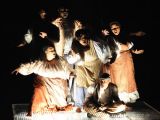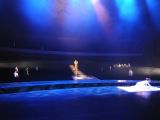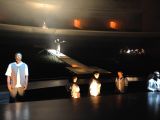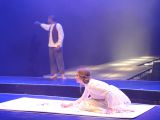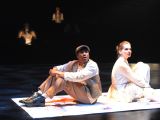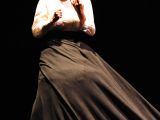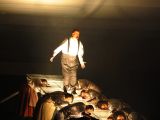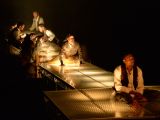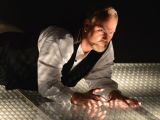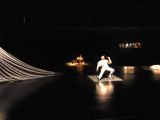About
Conceivend and staged by Andreas Mitisek within and above the audience seats of the 2,500 seat Terrace Theater, with the audience seated on the stage of the theater looking into the auditorium. The audience seats become the field of dissapearance. The three part orchestra pit elevator was used as stage, individually moving up and down.
A striking aspect of all this was that the entire audience was seated (uncomfortably) on stage facing out into the rather vast auditorium of the Terrace Theatre. When the curtain went up, the auditorium was revealed to us as a gaping black chasm with fog everywhere obscuring our vision. A small orchestra literally seemed to float in space somewhere in the distance. Actors emerged from all sorts of unexpected places among the rows of seats and then vanished into a void. Much use was made of the two-section pit elevator. The visuals were stunning and even incorporated the distant doors of the balcony. A metal hanamichi runway slashed down the center of the orchestra stalls and was used effectively in the perplexing disappearance,...looking out at a non-existent audience was a perfect metaphor for the entire work. –– Opera West
For the Long Beach Opera production -- staged and designed by the company’s artistic and general director, Andreas Mitisek –- the theater is kept foggy. The excellent Lyris String Quartet sits off in the distance, as if in another realm. A platform, lighted from underneath, extends into the theater for some of the action. Mrs. Williamson, sung with powerful intensity by Suzan Hanson, rises and descends the pit elevator. She stands on stilts; her long skirt, which flows at an angle, is taller than she is. –– LA TIMES
Reviews
Long Beach is busy making history with a show that, like poor (or maybe blessed) Mr. Williamson, will soon disappear.
I thought this difficult field was one of the finest and most inspired achievements of LBO’s artistic and general director/stage director/production designer/total genius Andreas Mitisek.
...it certainly ranks among the most important operatic events of the season. Mitisek teases out the paradoxical strands of Wellman’s determinedly indecipherable thesis and physically projects its complexities through light, costume, movement and, above all, dexterously deployed music and song. Mitisek’s staging adds immeasurably to the dimension of the experience by complementing the implacable ambiguities with startlingly original manipulations of space and sound. The disturbing climactic effect of ourselves witnessing Williamson dematerializing into the darkness may be one of the scariest experiences in any operatic show.
Mitisek has made a habit of staging opera in unusual spaces, or of using the available space in unexpected ways; this may be his neatest scenic conceit yet. I was amazed, in the best sense, by the impact of this production, which I may well decide is the best thing I've seen, anywhere, in the past several years.
Credits
Conductor: Benjamin Makino
Stage Director/Concept: Andreas Mitisek
Lighting Designer: Dan Weingarten
Lyris Quartet
Mrs. Williamson: Suzan Hanson
Mr. Williamson: Mark Bringelson
Williamson Girl: Valerie Vinzant
Boy Sam: Eric B. Anthony
Armour Wren/Andrew: Robin Buck
Virginia Creeper/Ensemble: Dabney Ross Jones
Old Woman/Ensemble: Amber Mercomes
Man/Ensemble: Nicholas Shelton
Ensemble: Lesili Beard, Jessica Elisabeth, Marcus Paige
Joel Brown, Matthew Lofton
Conductor: Kristof Van Grysperre
Stage Director/Concept: Andreas Mitisek
Lighting Designer: Dan Weingarten
Mrs. Williamson: Suzan Hanson
Mr. Williamson: Mark Bringelson
Williamson Girl: Valerie Vinzant
Boy Sam: Eric B Anthony
Armour Wren/Andrew: Robin Buck
Woman/Ensemble: Lindsay Patterson
Man/Ensemble: Michael Paul Smith
Ensemble: Saundra Hall Hill, Jennifer Lindsay, Matthew Lofton, Marcus Page, Alex Perkins
LYRIS QUARTET:
Alyssa Park, violin; Shalini Vijayan, violin;
Caroline Buckman, viola; Timothy Loo, cello

